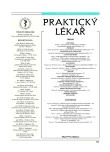Immunoadsorption therapy: Present-day options and perspectives
Authors:
J. Pták
Authors‘ workplace:
Krevní centrum Fakultní nemocnice s poliklinikou, Ostrava
primářka MUDr. Z. Čermáková
Published in:
Prakt. Lék. 2005; 85(10): 555-560
Category:
Of different specialties
Overview
Presented briefly are the characteristics of therapeutical exchange plasmapheresis, its advantages, shortcomings, and application in clinical practice along with its historical development into semi-selective and selective elimination methods. Defined are immunoadsorption along with its variants (non-selective, semiselective, and selective) adsorption methods and each type of adsorbent along with a listing of clinical indications in each of the medical disciplines. Described is the immunoadsorption of immunoglobulins as well as the options of adsorbing lipoproteins. Presented are new indications of immunoadsorption therapy in transplantation medicine, in the treatment of autoimmune diseases, sepsis, and in the broader framework of extracorporeal elimination methods there are also presented new options in the application of hemorheotherapy and filtration methods of cytoreduction leukocytapheresis in the treatment of inflammatory affection of the digestive tract and rheumatoid arthritis.
Key words:
immunoadsorption – plasmapheresis – adsorption of lipoproteins.
Labels
General practitioner for children and adolescents General practitioner for adultsArticle was published in
General Practitioner

2005 Issue 10
Most read in this issue
- Infantile autism from the point of view of developmental psychopathology. Theory of the psychological basis of autism
- Recent view on the pathophysiology and pharmacotherapy of the depressive disorder
- Rickettsia conori – infection imported from the South African Republic
- Surgical treatment of laryngeal carcinoma
